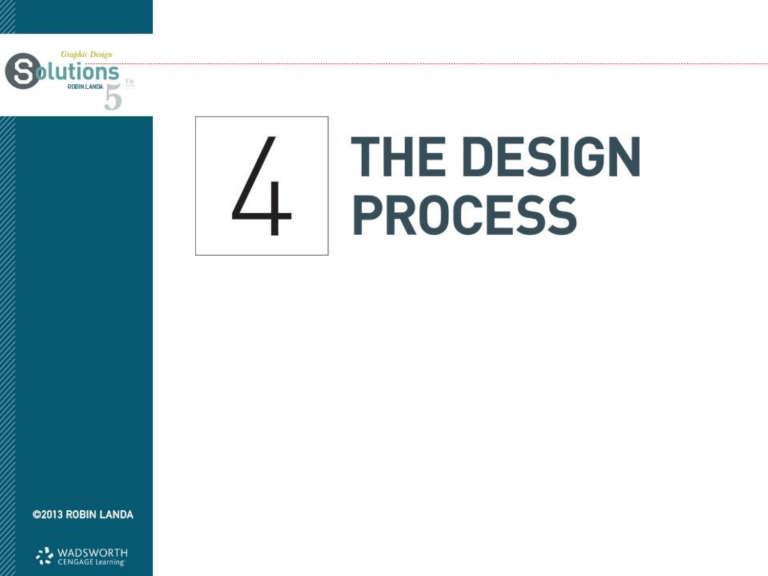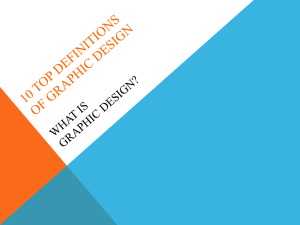Design Solutions Chapter Four

Objectives
• Learn phase 1 of the design process: Orientation
• Learn phase 2 of the design process: Analysis
• Gain knowledge of a design brief
• Learn phase 3 of the design process: Conception
• Understand the steps of concept generation
• Learn phase 4 of the design process: Design
• Learn phase 5 of the design process: Implementation
Definitions
• An audience is the targeted, specified group of people at whom you are aiming your visual communication.
• A design concept is the designer’s primary reasoning that forms the basis for a graphic design solution.
• Strategy is the core tactical underpinning of any visual communication, unifying all planning for every visual and verbal application within a program of applications.
• A design brief is a strategic plan that both the client and design studio or advertising agency agree upon; a written document outlining and strategizing a design project.
• A comprehensive is a detailed representation of a design concept thoughtfully visualized and composed.
• Production, also called digital prepress, includes preparing digital files utilizing industry-standard software.
Phase 1: Orientation
Phase 1 is orientation—the process of becoming familiar with your assignment, the graphic design problem, and the client’s business or organization, product, service, or group.
• Usually, junior designers and junior art directors or copywriters are not involved in strategic planning or in design brief formation.
More often, juniors are challenged by a simple design brief that has been distilled for them by their design director or art director.
Phase 1: Orientation
Conducting the Orientation
• During this initial phase, you and your team learn about the assignment. Since designers and art directors work in a variety of settings, who conducts the orientation and how it is conducted depends on the nature of your firm.
• Ascertaining essential information happens during this phase.
• For most assignments, there are standard questions, and some will be revisited during the next phase of analysis.
Questions will vary depending on the design application.
• Orientation also involves reviewing and evaluating the current graphic design solutions, branding, and/or advertising program created for this product, service, or group.
Phase 1: Orientation
The Audience
• Equally important during orientation is learning about the
audience—the targeted, specified group of people at whom you are aiming your visual communication.
The audience is the main relevant group who would purchase this brand or utilize this information, service, or product, or patronize this entity or who can influence others.
Knowing about the audience is critical.
Hope, Help & Healing (NCADD): Posters
Lara McCormick
Phase 1: Orientation
Material Gathering
• To design, first you must learn about the sector, the product, service, company, or organization, the company’s history, core values and attributes, mission, and of course, the audience.
Every designer must be informed about his or her sector under assignment, the client’s business, and the problem under assignment.
Not only does gathering information about the client’s business help you solve the assignment, but it also enriches your general wealth of knowledge.
Gathering Information Through Listening
• During this first phase of the design process, you get the lay of the land and obtain as much raw materials as you can.
Active listening entails concentrating, focusing on the content of the speaker’s message, interpreting what the client says and means, and actively reflecting on what has been said.
Phase 2: Analysis
Once Phase 1 is completed, the next phase is analysis— examining all you have unearthed to best understand, assess, and strategize to move forward with the assignment.
• After reflective thinking, you develop the direction your solution(s) will take. When you analyze, you
Examine each part of the problem
Concisely and accurately define constituent elements
Organize the information so it is broken down into parts that are easily analyzable
Draw conclusions based on your analysis that will allow you to move forward to the next step
Phase 2: Analysis
Discovery and Strategy
• Strategy is the core tactical underpinning of any visual communication. It unifies all planning for all design and copy within a strategic program or campaign.
A clearly defined strategy directs all strategic and creative expressions, and keeps the client and creative professionals on the same page.
The Design Brief
• A design brief is a strategic plan that both the client and design firm or advertising agency agree upon, a written document outlining and strategizing a design project; it is also called a
creative brief, brief, or creative work plan.
Phase 2: Analysis
The Design Brief
• Design briefs may take different forms.
• Some sample creative brief questions may include the following:
What is our challenge?
Who is the core audience?
What is the audience’s perception of the brand or group?
What would you like the core audience to think and feel?
What specific information and thoughts will assist in this
change?
What is at the core of the brand personality?
What is the key emotion that will build a relationship with the core audience?
What media will best facilitate our goal?
What are the most critical executional elements and what Is the budget?
What is the single most important takeaway?
What do we want the audience to do?
Phase 3: Conception
A foundational concept drives the design. A design concept is the creative reasoning underpinning a design.
• The design concept sets the framework for all your design decisions. It is the primary broad abstract idea driving the hows and whys of your design decisions.
• A design concept is visually expressed through the creation, selection, combination, manipulation, and arrangement of visual and type elements.
For any assignment, a design studio or agency must generate several viable concepts to present to their client
Opus: Logo
Tricycle, Inc., Chattanooga, TN
Phase 3: Conception
Concept-Generation Process
• The generally accepted protocol for graphic design conception is based on the four-stage model outlined in The Art of
Thought by Graham Wallas:
• Preparation > Incubation > Illumination > Verification
Preparation
• Thoroughly examine your materials for insights.
• Examine for connections among thoughts and/or facts. Then correlate to find an insight or idea platform.
• Write any idea or insight on an index card, in a notebook, or in a digital file.
Incubation
• Once you have examined all the materials, allow the information to incubate in your mind.
• By allowing the problem to incubate in the back of your mind, your subconscious may do the job for you.
Phase 3: Conception
Illumination / Conception
• For many, a concept pops up as if out of a magic lamp.
• When we are relaxed and not directly working at concept generation, an idea comes to us.
However, if incubation has not worked for you, consider alternative forms of concept generation.
Verification
• Once you generate a concept, you need to evaluate it, testing for both functionality and creativity.
This is the point in the process to keenly critique your own concepts.
Verification involves evaluating/assessing and logically supporting your viewpoint.
Phase 4: Design
Finally, it’s time to design. Now your design concept takes articulate visual form.
• For many, this is a nonlinear process, where the steps vary markedly as a result of creative thinking and designing.
Individual factors or circumstances cause designers to follow different paths with deviations from those paths.
Step 1: Thumbnail Sketches
• Thumbnail sketches are preliminary, small, quick, unrefined drawings of your ideas in black and white or color.
Best practice dictates that you use traditional imagemaking techniques—sketch by hand using a drawing tool, such as a pencil, marker, or pen, or digital pen and tablet.
Step 2: Roughs
• Roughs are larger and more refined than thumbnail sketches.
The purpose of this stage is to flesh out a few of your best ideas, before going to a final stage.
Phase 4: Design
Step 3: Comprehensives
• A comprehensive, referred to as a comp, is a detailed representation of a design concept thoughtfully visualized and composed.
When a client sees a comp, he or she will see a very close representation of how the piece will look when produced.
Client Review During Phase 4
• At this point, clients often request changes and refinements.
During this phase, the designer evaluates, refines, and secures approval from the client.
Very often, the comp is used as a visual agreement of the design solution between the designer and client and as a guide or “blueprint” for the printer
Phase 5: Implementation
For a graphic design student, execution means either printing one’s solution on a home printer or displaying it on screen to one’s instructor or crafting a mock-up.
In a professional setting, implementing one’s design solution takes a variety of forms depending on the kind of format and whether the format is print, screen-based, or environmental.
Gilda’s Club Chicago Living with Cancer Workbook
© Brainforest, Chicago
Phase 5: Implementation
• Very often, designers go on press to assure accuracy and may work closely with the printer.
• Production, also called digital prepress, includes preparing the digital files utilizing industry-standard software, collecting all needed photographs and/or illustrations and having them scanned, preparing font folders and image folders, proofreading (with or without the client), and following through by working with the printer or the web designer.
Gilda’s Club Chicago Living with Cancer Workbook
© Brainforest, Chicago
Phase 5: Implementation
• Craftsmanship refers to the level of skill, proficiency, and dexterity of the execution.
• Well-crafted work enhances good design concepts.
Many students display their portfolios on websites, on mobile or other digital devices, or in PDFs.
Some employers still prefer to see hard copies— comprehensives and mock-ups in portfolios.
Design solutions should be neat, clean, accurate, functional, and ecologically mindful.
• Presentation—the manner in which comps are presented to a client or the way work is presented in your portfolio—is important.
A great presentation can truly enhance your chances of selling your solution to a client.
Make it accurate, make it neat, present it professionally.
Debriefing
After a design assignment has ended, some clients and designers find debriefing useful.
• This involves reviewing the solution and its consequences— examining your finished assignment to determine what went right and what went wrong.
Summary
• Orientation is the process of becoming familiar with your assignment, the graphic design problem, and the client’s business or organization, product, service, or group.
• The audience is the targeted, specified group of people at whom you are aiming your visual communication. Knowing about the audience is critical.
• Analysis involves examining all you have unearthed to best understand, assess, and strategize to move forward with the assignment.
• A clearly defined strategy directs all strategic and creative expressions, and keeps the client and creative professionals on the same page.
• The design concept sets the framework for all your design decisions. It is the primary broad abstract idea driving the hows and whys of your design decisions.
Summary
• The generally accepted protocol for graphic design conception is: Preparation > Incubation > Illumination > Verification.
• For many, design is a nonlinear process, where the steps vary markedly as a result of creative thinking and designing.
Individual factors or circumstances cause designers to follow different paths with deviations from those paths.
• For a graphic design student, execution means either printing one’s solution on a home printer or displaying it on screen to one’s instructor or crafting a mock-up.
• In a professional setting, implementing one’s design solution takes a variety of forms depending on the kind of format and whether the format is print, screen-based, or environmental.











